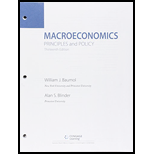
To ascertain: The velocity of each year and comparison of trend.
Explanation of Solution
Calculation of velocity of money
According to Fisher's quantity theory of money, the
Where,
M = Money supply
V = Velocity of money
P = General Price level
Y = Total output
MV refers to the supply of money and PY refers to the demand for money.
To calculate the velocity of money, Equation (1) can be written as follows:
ln Equation (2), PY refers to
United States money supply and GDP The following table shows the money supply and GDP of the United States for different years.
Table (1)
| Year | Money Supply | GDP |
| 2006 | 1,367 | 13,399 |
| 2007 | 1,375 | 14,062 |
| 2008 | 1,602 | 14,369 |
| 2009 | 1,697 | 14,119 |
United States velocity of money in the year 2006
Substitute the 2006 money supply and GDP in Equation (3) to obtain the velocity of money for the United States. This can be written as follows:
Hence, the velocity of money for the United States in the year 2006 was 9.8
United States velocity of money in the year 2007
Substitute the 2007 money supply and GDP in Equation (3) to obtain velocity of money for the United States. This can be written as follows:
Hence, the velocity of money for the United States in the year 2007 was 10.23
United States velocity of money in the year 2008
Substitute the 2008 money supply and GDP in Equation (3) to obtain velocity of money for the United States. This can be written as follows:
Hence, the velocity of money for the United States in the year 2008 was 8.97
United States velocity of money in the year 2009
Substitute the 2009 money supply and GDP in Equation (3) to obtain velocity of money for the United States. This can be written as follows:
Hence, the velocity of money for the United States in the year 2009 was 8.32
United States money supply, GDP, and velocity of money
The following table shows the United State's money supply, GDP, and velocity of money for different years.
Table (1)
| Year | Money Supply | GDP | Velocity |
| 2006 | 1,367 | 13,399 | 9.8 |
| 2007 | 1,375 | 14,062 | 10.23 |
| 2008 | 1,602 | 14,369 | 8.97 |
| 2009 | 1,697 | 14,119 | 8.32 |
From the above table, it is observed that there is a continuous sharp decreasing trend in velocity of money during 2006 to 2009 except for the year 2007.
United States money supply, GDP, and velocity of money
The following table shows the United State's money supply, GDP, and velocity of money for different years.
Table (2)
| Year | GDP | M1 Money Supply | V=GDP/M |
| 1975 | 1,663.70 | 287.10 | 5.79 |
| 1976 | 1,824.10 | 306.20 | 5.96 |
| 1977 | 2,030.10 | 330.90 | 6.14 |
| 1978 | 2,293.80 | 357.30 | 6.42 |
| 1979 | 2,562.20 | 381.80 | 6.71 |
| 1980 | 2,788.10 | 408.50 | 6.83 |
| 1981 | 2,126.80 | 436.70 | 4.87 |
| 1982 | 3,253.20 | 474.80 | 6.85 |
| 1983 | 3,534.60 | 521.40 | 6.78 |
| 1984 | 3,930.90 | 551.60 | 7.13 |
| 1985 | 4,217.50 | 619.80 | 6.80 |
| 1986 | 4,460.10 | 724.70 | 6.15 |
| 1987 | 4,736.40 | 750.20 | 6.31 |
| 1988 | 5,100.40 | 786.70 | 6.48 |
| 1989 | 5,482.10 | 792.90 | 6.91 |
| 1990 | 5,800.50 | 824.70 | 7.03 |
| 1991 | 5,992.10 | 897.00 | 6.68 |
| 1992 | 63,420.30 | 1,024.90 | 61.88 |
| 1993 | 6,667.40 | 1,129.60 | 5.90 |
| 1994 | 7,085.20 | 1,150.60 | 6.16 |
| 1995 | 7,414.70 | 1,127.50 | 6.58 |
Comparison of velocity of money between 1975 to 1985 and 2006 to 2009
During 2006 to 2009, there is a consistent fall in velocity of money, whereas during 1975 to 1985, the velocity of money shows a mixed trend, that is, there is no consistency in trend.
Introduction:
Definition of M1
M1 money refers to the total amount of money in the circulation and savings with banks and other saving institutions.
Velocity of money
Velocity of money refers to how many times the total money supply circulated in the economy in a given period of time.
Want to see more full solutions like this?
- Use a game tree to illustrate why an aircraft manufacturer may price below the current marginal cost in the short run if it has a steep learning curve. (Hint: Show that learning by doing lowers its cost in the second period.) Part 2 Assume for simplicity the game tree is illustrated in the figure to the right. Pricing below marginal cost reduces profits but gives the incumbent a cost advantage over potential rivals. What is the subgame perfect Nash equilibrium?arrow_forwardAnswerarrow_forwardM” method Given the following model, solve by the method of “M”. (see image)arrow_forward
- As indicated in the attached image, U.S. earnings for high- and low-skill workers as measured by educational attainment began diverging in the 1980s. The remaining questions in this problem set use the model for the labor market developed in class to walk through potential explanations for this trend. 1. Assume that there are just two types of workers, low- and high-skill. As a result, there are two labor markets: supply and demand for low-skill workers and supply and demand for high-skill workers. Using two carefully drawn labor-market figures, show that an increase in the demand for high skill workers can explain an increase in the relative wage of high-skill workers. 2. Using the same assumptions as in the previous question, use two carefully drawn labor-market figures to show that an increase in the supply of low-skill workers can explain an increase in the relative wage of high-skill workers.arrow_forwardPublished in 1980, the book Free to Choose discusses how economists Milton Friedman and Rose Friedman proposed a one-sided view of the benefits of a voucher system. However, there are other economists who disagree about the potential effects of a voucher system.arrow_forwardThe following diagram illustrates the demand and marginal revenue curves facing a monopoly in an industry with no economies or diseconomies of scale. In the short and long run, MC = ATC. a. Calculate the values of profit, consumer surplus, and deadweight loss, and illustrate these on the graph. b. Repeat the calculations in part a, but now assume the monopoly is able to practice perfect price discrimination.arrow_forward
 Macroeconomics: Principles and Policy (MindTap Co...EconomicsISBN:9781305280601Author:William J. Baumol, Alan S. BlinderPublisher:Cengage Learning
Macroeconomics: Principles and Policy (MindTap Co...EconomicsISBN:9781305280601Author:William J. Baumol, Alan S. BlinderPublisher:Cengage Learning



 Economics (MindTap Course List)EconomicsISBN:9781337617383Author:Roger A. ArnoldPublisher:Cengage Learning
Economics (MindTap Course List)EconomicsISBN:9781337617383Author:Roger A. ArnoldPublisher:Cengage Learning





